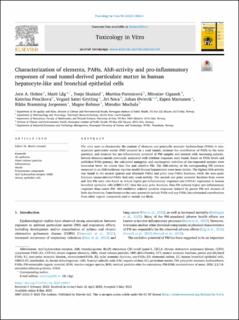Characterization of elements, PAHs, AhR-activity and pro-inflammatory responses of road tunnel-derived particulate matter in human hepatocyte-like and bronchial epithelial cells
Holme, Jørn Andreas; Låg, Marit; Skuland, Tonje Schwach; Parenicová, Martina; Ciganek, Miroslav; Penciková, Katerina; Grytting, Vegard Sæter; Neca, Jiri; Øvrevik, Johan; Mariussen, Espen; Jørgensen, Rikke Bramming; Refsnes, Magne Arnold; Machala, Miroslav
Peer reviewed, Journal article
Published version
Permanent lenke
https://hdl.handle.net/11250/3080694Utgivelsesdato
2023Metadata
Vis full innførselSamlinger
Sammendrag
The aims were to characterize the content of elements and polycyclic aromatic hydrocarbons (PAHs) in size-separated particulate matter (PM) sampled in a road tunnel, estimate the contribution of PAHs to the toxic potential, and measure the pro-inflammatory potential of PM samples and extracts with increasing polarity. Several elements/metals previously associated with cytokine responses were found. Based on PAHs levels and published PAHs potency, the calculated mutagenic and carcinogenic activities of size-separated samples were somewhat lower for coarse than fine and ultrafine PM. The AhR-activity of the corresponding PM extracts measured in an AhR-luciferase reporter model (human hepatocytes) were more similar. The highest AhR-activity was found in the neutral (parent and alkylated PAHs) and polar (oxy-PAHs) fractions, while the semi-polar fractions (mono-nitrated-PAHs) had only weak activity. The neutral and polar aromatic fractions from coarse and fine PM were also found to induce higher pro-inflammatory responses and CYP1A1 expression in human bronchial epithelial cells (HBEC3-KT) than the semi-polar fractions. Fine PM induced higher pro-inflammatory responses than coarse PM. AhR-inhibition reduced cytokine responses induced by parent PM and extracts of both size fractions. Contributors to the toxic potentials include PAHs and oxy-PAHs, but substantial contributions from other organic compounds and/or metals are likely.

